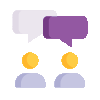The /j/ sound is made with the exact same mouth positioning as the /ch/ sound, but the /j/ sound is voiced. This means that the sound is produced comes from both the vibration of the vocal cords and from the movement of air through the mouth. To make the sound, put your teeth together and pull the corners of your lips to the middle to form a pucker. The tip of your tongue should rise to touch the top of your mouth just behind your front teeth as air passes through your mouth. The air will temporarily be blocked by your tongue on its way out before being released from your lips.
Children usually develop the /j/ sound a bit later, starting at age four. Since this sound is a little more challenging, it is still considered within the normal range for children to work on developing the sound through age seven. However, if your child is still struggling with the /j/ sound after seven years old, it is best to seek out the help of a licensed speech-language pathologist. The sooner a speech problem is treated, the less likely that it will become a larger and much more severe issue later.
Practicing articulation with your child is a great way to help stimulate their language development at home or in conjunction with a speech therapist. Here are some fun tips to help you get started with your little one:
- Verbal cues
When practicing individual sounds with your child, it is important to begin by saying the sound slowly and clearly for your child: “/j/, /j/, /j/” This helps your little one to understand what sound you are focusing on and gives them a good example to imitate. Have your child repeat the sound back to you. Gradually, as she begins to master the sound in isolation, add vowels to the sound to form simple syllables, such as “jo, jo, jo,” “jay, jay, jay,” and “jee, jee, jee.” With practice and time, your child will be able to move on to words, sentences, and even conversations with the /j/ sound.
- Visual cues
Often when a visual cue accompanies a sound, it helps children remember what their mouth is supposed do in order to make the sound. For the /j/ sound, place your thumb in one corner of your mouth and your other fingers at the other corner and draw them together around your mouth as you say the sound, so that your hand pinches together in the same way the lips do. Have your child do this as well when they make the sound. Encourage your child to practice this in the mirror for additional visual feedback.
- Tactile cues
Since the /j/ sound is a voiced sound, the vocal cords vibrate when the sound is pronounced. You can feel this vibration by putting your hand on your neck when you say the sound. Have your little one feel your throat, and then her own. Kids get a kick out of feeling this and it helps remind them that they are saying the sound correctly.
- Awesome /j/ Activity
J is for Jumping! Place a few washcloths or placemats on the floor of your kitchen or living room so they look like lily pads on a pond. Tell your kiddo that the goal is to jump all the way to the end, but she has to “jump!” three times correctly before actually jumping to the next lily pad. Your little froggy will master the sound soon enough!












